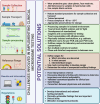Challenges for pathologists in implementing clinical microbiome diagnostic testing
- PMID: 39289163
- PMCID: PMC11407905
- DOI: 10.1002/2056-4538.70002
Challenges for pathologists in implementing clinical microbiome diagnostic testing
Abstract
Recent research has established that the microbiome plays potential roles in the pathogenesis of numerous chronic diseases, including carcinomas. This discovery has led to significant interest in clinical microbiome testing among physicians, translational investigators, and the lay public. As novel, inexpensive methodologies to interrogate the microbiota become available, research labs and commercial vendors have offered microbial assays. However, these tests still have not infiltrated the clinical laboratory space. Here, we provide an overview of the challenges of implementing microbiome testing in clinical pathology. We discuss challenges associated with preanalytical and analytic sample handling and collection that can influence results, choosing the appropriate testing methodology for the clinical context, establishing reference ranges, interpreting the data generated by testing and its value in making patient care decisions, regulation, and cost considerations of testing. Additionally, we suggest potential solutions for these problems to expedite the establishment of microbiome testing in the clinical laboratory.
Keywords: microbiome; microbiome testing; pathologist; pathologist and microbiome.
© 2024 The Author(s). The Journal of Pathology: Clinical Research published by The Pathological Society of Great Britain and Ireland and John Wiley & Sons Ltd.
Figures
Similar articles
-
Specimen collection and storage for diagnostic molecular pathology investigation.Arch Pathol Lab Med. 1996 Jun;120(6):591-6. Arch Pathol Lab Med. 1996. PMID: 8651865 Review.
-
The Role of the Pathologist in Population Health.Arch Pathol Lab Med. 2019 May;143(5):610-620. doi: 10.5858/arpa.2018-0223-CP. Epub 2018 Nov 6. Arch Pathol Lab Med. 2019. PMID: 30398912 Review.
-
Effects of Specimen Collection Methodologies and Storage Conditions on the Short-Term Stability of Oral Microbiome Taxonomy.Appl Environ Microbiol. 2016 Aug 30;82(18):5519-29. doi: 10.1128/AEM.01132-16. Print 2016 Sep 15. Appl Environ Microbiol. 2016. PMID: 27371581 Free PMC article.
-
Current Trends and Challenges of Microbiome Research in Prostate Cancer.Curr Oncol Rep. 2024 May;26(5):477-487. doi: 10.1007/s11912-024-01520-x. Epub 2024 Apr 4. Curr Oncol Rep. 2024. PMID: 38573440 Review.
-
The ever-evolving role of pathologists in the management of breast cancer with neoadjuvant treatment: recommendations based on the Spanish clinical experience.Clin Transl Oncol. 2018 Mar;20(3):382-391. doi: 10.1007/s12094-017-1725-z. Epub 2017 Aug 9. Clin Transl Oncol. 2018. PMID: 28795336
References
-
- Tremaroli V, Backhed F. Functional interactions between the gut microbiota and host metabolism. Nature 2012; 489: 242–249. - PubMed
Publication types
MeSH terms
LinkOut - more resources
Full Text Sources
Research Materials



